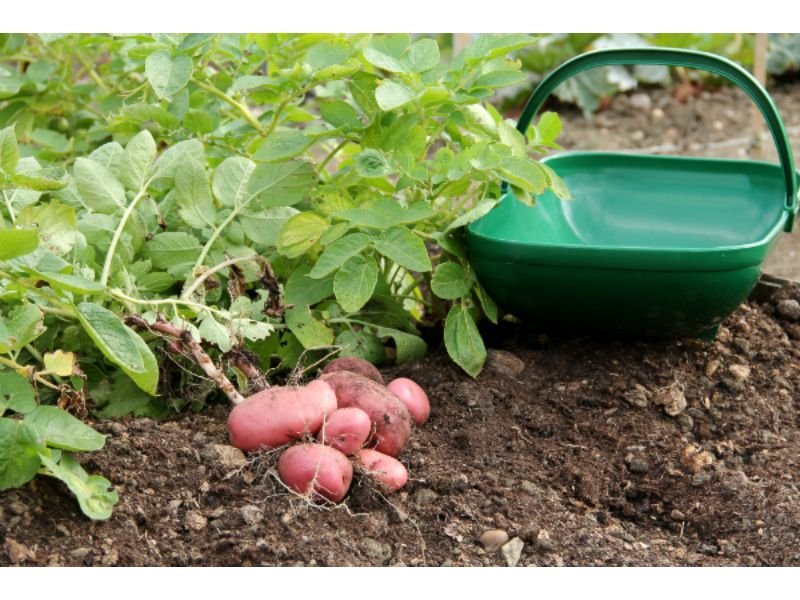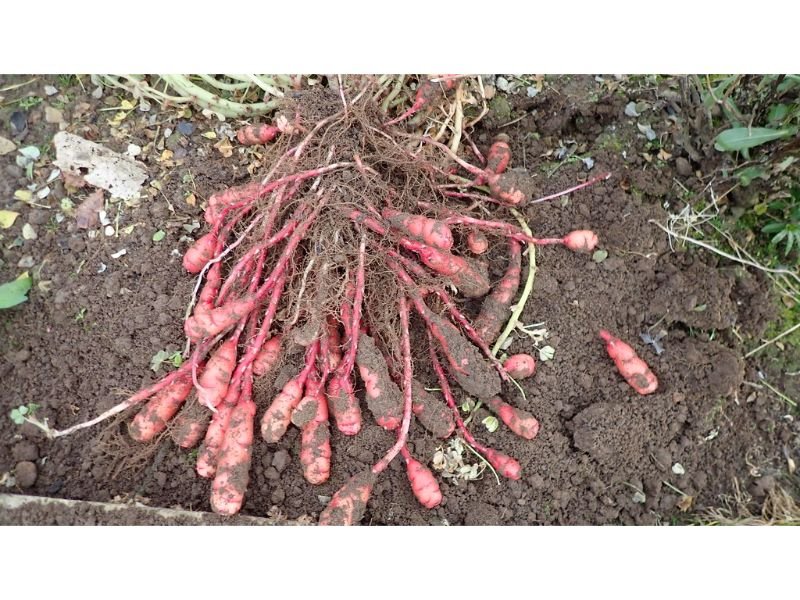Tubers are root systems that are adapted for storing starch and other nutrients. Tubers Root come in many shapes and sizes and can be found growing on the roots of various types of plants, including some tropical and subtropical species. Tubers are generally considered to be a type of “modified root” because they lack the fibrous structure and characteristic branching typical of other plant root systems.
Table of Contents
How to distinguish tubers root system
The most noticeable difference between tubers and other root systems is their shape, which is usually round or ovoid. These underground storage organs also have specialized skin — sometimes referred to as epidermis — that helps protect them from desiccation and disease-causing agents such as fungi, bacteria, viruses, or nematodes. In addition to providing an efficient way to store energy reserves for future growth, tubers also offer protection from environmental stresses such as cold or drought.

For gardeners who want to identify tuberous plants in their gardens, it is important to look at both the leaves of the plant (if any) as well as its roots for clues about its identity. Tubers tend to have fewer branches than regular taproots (the vertical part of a normal root system), but they will typically have multiple offshoots with more branches than what you’d find on fibrous root systems. Additionally, when cut crosswise into tuberous plants often reveal distinct star-shaped structures known as stolon (or rhizomes). While these features vary somewhat depending on the species in question, they all serve the purpose of helping the plant absorb nutrient more efficiently throughout its lifespan soil supply.
What are the benefits of Tubers root systems for human?
Tubers root is a type of plant that has many benefits for human health. It is rich in vitamins and minerals, and provides a good source of dietary fiber. It can be eaten raw or cooked, and can be used to make soups, stews, casseroles, sauces, breads and other baked goods. Tubers root also has the potential to help reduce cholesterol levels in the body due to its high content of soluble fibers.
Low calorie
Tubers roots are low calorie but nutrient dense foods that provide essential energy without overloading your diet with unhealthy fats or sugars. They contain several minerals such as potassium, magnesium and calcium which help with bone strength and maintenance of regular blood pressure levels. Additionally, tubers root provide Vitamins A & C which are important for healthy eyesight and skin health respectively.
High in prebiotics
Tubers root are also high in prebiotics which have been found to improve digestion by promoting healthy bacteria growth in the intestine. In addition, they can help maintain weight loss goals since they are incredibly filling due to their high fiber content – one serving contains as much fiber as four slices of whole wheat bread! The complex carbohydrates present in tubers root provide slow release energy while helping keep blood sugar levels stable throughout the day – perfect for those watching their weight!
Anti-inflammatory properties
Last but not least tubers root have anti-inflammatory properties which can ward off inflammation associated with diseases like arthritis or asthma. All these benefits combined create a great food option for all kinds of diets! Whether you’re looking to maintain your current fitness level or just looking for new ways to incorporate nutritious foods into your diet – incorporation of tubers root should be seriously considered!
What are the benefits of Tubers root systems for plants?
Root tubers are an important part of many different plant species. They provide a nutrient-rich food source for the plant, store energy in their cells, enable the plant to survive drought and extreme temperatures, fix nitrogen from the soil and allow them to spread further across a landscape by creating new plants from root cuttings. As well as being beneficial to the plants, root tubers are edible for humans or used as animal feed. Let’s take a look at some of the ways that root tubers benefit plants:
Nutrient Rich Food Source
Root tubers offer an abundance of nutrients that help keep a plant healthy. Tubers contain high levels of carbohydrates and proteins which are essential for growth and development. Potatoes have one of the highest levels of dietary carbs compared to other vegetables; they also contain potassium, magnesium, iron and zinc amongst other minerals. These vital nutrients aid with photosynthesis in plants that require it for survival; it helps convert sunlight into energy which can be stored within the tuber itself as glucose or converted into starches to be used later on in times when light is limited.
Storage & Survival
Tubers act like storage tanks where energy reserves can be kept safely until they’re needed in periods when light availability is low or there is a shortage of water or nutrients. This means that during these difficult times plants can still survive off this stored energy without worrying about having enough resources available elsewhere. Starch is what gets accumulated during periods when excess sunlight has been absorbed by leaves and converted into glucose via photosynthesis; this starch then turns into additional food stores inside the root tuber once it matures itself over time through cell growth processes known as secondary thickening.
Fix Nitrogen & Spread Further Across Landscape
One essential function performed by root tubers is their ability to fix nitrogen from the environment – this process involves converting atmospheric nitrogen gas (N2) into ammonia (NH3). Once ammonia has been produced it then binds with clay particles present in soil forming ammonium ions (NH4+) which are much more accessible forms of nitrogen needed by plants for growth purposes such as photosynthesis or protein formation within its own cells; without sufficient nitrogen available these functions wouldn’t occur efficiently. This could lead to stunted growth rates directly translating into lower production yields long term.
Root tubers also help species spread further across landscapes over time due to their ability to generate new offspring from cuts made along their surface layer(s). Contained within each cutting would be some form viable cells – capable of producing entire roots systems given adequate environmental conditions such allowing them propagated successfully beyond initial release points eventually creating clusters similar looking ones with close genetic makeups growing throughout selected areas indefinitely!
Some plants with tubers roots
Plants that have tubers as roots are some of the most useful and versatile plants in gardening, farming and landscaping. They produce an abundant crop of edible or ornamental fruits and vegetables, require minimal care and maintenance, and can often be stored for months after harvesting. Tubers can also be used to propagate new plants from a single original tuber or to create clumps of identical plants from one tuber.
Potato (Solanum tuberosum).

The best known plant with a tuber root is the potato (Solanum tuberosum). The potato plant produces small underground tubers which are rich in starch, making them especially tasty when boiled or baked. Potatoes are capable of producing very high yields if they receive the proper amount of sunlight, moisture, fertilizer, and pesticide protection.
Sweet potato (Ipomoea batatas)

Another common tuber-root plant is sweet potato (Ipomoea batatas), which produces an abundance of bright orange tubers that taste great mashed or baked into chips. Sweet potatoes prefer well-drained soil with lots of organic matter mixed in; they tend to do best when cultivated in late summer/early autumn so that their roots have time to fully develop before harvest time.
Parsnips (Pastinaca sativa)

Parsnips (Pastinaca sativa) are another option for having a tuber root; these white-fleshed roots are delicious roasted or pureed into soup stock. Parsnips prefer deep soil with adequate moisture levels throughout the growing season; too little water will cause their flesh to become rock hard while over-watering may make them mushy.
Yams (Dioscorea spp.)

Yams (Dioscorea spp.) are a final example worth noting; these starchy tubers come in many varieties featuring different sizes, shapes, colors, tastes, and textures – all depending on which species you’re cultivating! Yams need well-drained soil with plenty of air circulation for optimal growth; too much water can lead to rot setting in so it’s important to be careful not to overwater them during warmer months.
Tubers offer a wide variety of options when it comes to sprucing up your garden or adding some extra nutrition onto your plate! From classic potatoes to exotic yams there is sure to be something in this category that meets your needs – just remember that each type requires its own unique set up for the perfect results!
Tubers are an important component of many flowering plants’ life cycles; distinguishing them from other types of roots can help gardeners provide optimal care for their favorite blooms!

Gardening is my passion and growing plants indoors has always been a stress relief for me. Grow a banana tree in my apartment once (although failed to produce bananas).






